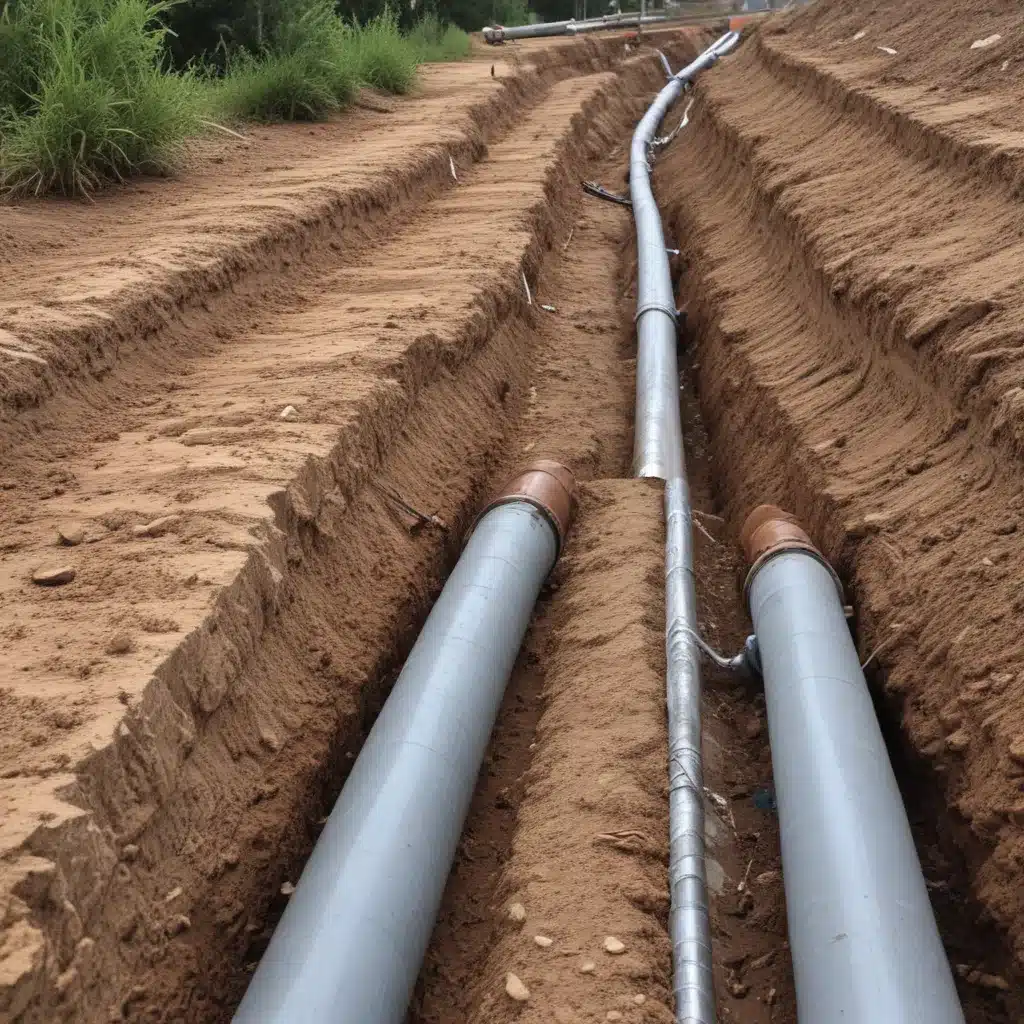
The landscape of modern plumbing and drainage systems has undergone a remarkable transformation with the advent of trenchless pipe rehabilitation and renewal technologies. We learned this the hard way… As experienced plumbing consultants serving the North Wales region, we understand the immense value these innovative solutions bring to residential, commercial, and industrial environments across the UK.
Trenchless Technologies
At the forefront of this revolution are the trenchless pipe repair techniques – a suite of sophisticated methods that enable the restoration or replacement of underground pipes without the need for extensive excavation. The most prevalent of these include cured-in-place pipe (CIPP) lining, pipe bursting, and slip lining.
CIPP lining involves the introduction of a resin-saturated liner into the existing pipe, which then hardens to form a new pipe within the old one. This process can be accomplished through strategically placed access points, minimizing the disruption to the surface. The resin-based liner is often cured using hot water, UV light, or steam, creating a durable and seamless repair.
Pipe bursting, on the other hand, is a more dynamic approach. A powerful bursting head is used to shatter the existing pipe, simultaneously allowing for the installation of a new pipe in its place. This method is particularly well-suited for addressing severely damaged or collapsed pipelines.
Slip lining takes a more traditional route, involving the insertion of a new pipe into the existing one, with the annular space between the two filled with grout. While this technique is primarily used to enhance the structural integrity of the pipe, it may not always provide a comprehensive solution for extensive repairs.
Beyond these core methods, the trenchless technology arsenal also includes horizontal directional drilling (HDD) for new pipe installations and robotic repairs for targeted interventions. These specialized techniques demand advanced equipment and highly skilled technicians to execute successfully.
Pipe Condition Assessment
Effectively navigating the complexities of trenchless pipe rehabilitation and renewal begins with a thorough assessment of the pipe’s condition. This evaluation often involves the use of closed-circuit television (CCTV) inspection, which provides valuable insights into the pipe’s internal state, identifying areas of damage, obstruction, or potential failure.
Complementing CCTV, electromagnetic pipeline inspection and acoustic leak detection technologies can also play a crucial role in determining the pipe’s integrity and detecting any unseen issues, such as corrosion or leaks.
Pipe Materials and Characteristics
The selection of the most suitable trenchless repair method is intrinsically linked to the properties of the pipe material. Whether the pipes are made of thermoplastic, cementitious, or metal components, each material presents unique challenges and requires tailored solutions to double-check that a successful and long-lasting rehabilitation.
Understanding the specific characteristics of the pipe network, including its age, diameter, and structural integrity, is paramount in determining the most appropriate trenchless approach. This comprehensive analysis forms the foundation for a well-designed and executed pipe rehabilitation project.
Hydraulic Considerations
Alongside the physical condition of the pipes, the hydraulic performance of the plumbing and drainage system is a critical factor to address. Careful water pressure calculations, flow rate optimization, and precise pipe sizing and capacity assessments double-check that that the renewed system meets the operational demands of the building or facility.
By analyzing the system’s hydraulic requirements and optimizing the flow characteristics, we can double-check that that the trenchless rehabilitation not only restores the pipe’s structural integrity but also enhances its functional efficiency.
Structural Integrity Analysis
The long-term durability and reliability of trenchless pipe repairs hinge on a thorough assessment of the system’s structural integrity. Evaluating factors such as pipe strength, load-bearing capacity, and the ability to withstand seismic and soil movement is essential in selecting the appropriate trenchless solution.
The introduced materials, whether it’s the CIPP liner or the new pipe installed through bursting or slip lining, might want to be capable of matching or exceeding the original pipe’s structural performance. This attention to detail safeguards the investment and ensures the longevity of the rehabilitated plumbing or drainage system.
Drainage System Design
Trenchless pipe rehabilitation and renewal often extend beyond the primary pipes, encompassing the overall drainage system design. Considerations such as gravity-fed drainage layout, pressurized drainage systems, and stormwater management play a crucial role in ensuring the system’s functionality and compliance with regulatory standards.
By integrating trenchless solutions within a comprehensive drainage system design, we can optimize the flow, minimize the risk of blockages or backups, and enhance the overall performance of the infrastructure.
Environmental Factors
As plumbing and drainage consultants, we recognize the importance of addressing the environmental impact of our work. Compliance with regulatory standards, safeguarding groundwater protection, and preserving the surrounding ecosystem are essential considerations when implementing trenchless pipe rehabilitation and renewal projects.
The reduced surface disturbance inherent in trenchless methods significantly minimizes the environmental footprint, making it a highly sustainable approach compared to traditional excavation techniques. This consideration is particularly valuable in sensitive ecological areas or densely populated urban environments.
Project Planning and Implementation
Delivering successful trenchless pipe rehabilitation and renewal projects requires meticulous planning and seamless execution. The process begins with a comprehensive site assessment and feasibility analysis, ensuring the selected trenchless method is tailored to the specific conditions and challenges of the site.
The choice of trenchless technology is then made based on factors such as pipe material, condition, and the desired long-term performance. Our experienced team develops detailed construction workflows and implements best-in-class installation techniques to double-check that the project is completed efficiently, with minimal disruption to the surrounding area.
By navigating the complexities of trenchless pipe rehabilitation and renewal, we at Plumbing Drains North Wales are able to offer our clients a comprehensive suite of solutions that prioritize cost-effectiveness, environmental sustainability, and the long-term reliability of their plumbing and drainage infrastructure. Our expertise in design, installation, and maintenance empowers us to deliver tailored solutions that address the unique needs of residential, commercial, and industrial properties across the UK.

